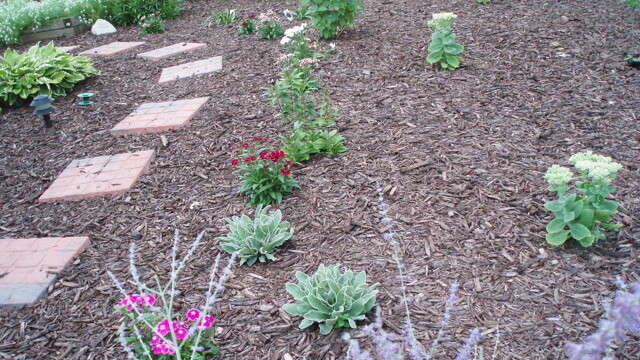No-Mow Lawns
a new movement away from the traditional grass yard

It wasn’t the mowing that drove Linda Soltis to an alternative lawn – it was the moles. Mole tunnels riddled the postage-stamp-sized patch of grass that she labored over watering, weeding, and fertilizing, and she was tired of it. Her solution? Mulching over the entire yard. It’s called a “No-Mow Lawn,” and the trend is taking hold of the Chippewa Valley.
The idea of “No-Mow” is that between fuel, emissions, fertilizers, pesticides, water consumption, and time, there’s far too many costs (environmental and otherwise) for a simple lawn. Grass must not be the only option.
In Soltis’ case, she combined several options into one yard. Basically a big garden, the lawn combines mulch, shrubs, raised flower beds, and paving stones. Other no-mowers prefer ornamental or low-growing vegetation like native prairie grasses, clover, moss, and other groundcovers. After transitioning to a no-mow, Soltis discovered that alternative lawns are more forgiving than traditional turf.
“[Grass lawns] are a lot of work and not a lot of reward,” she said. “It will go real nice and then you’ll have a big brown spot.”
Her yard’s increased flora variety attracts birds that usually avoid urban areas, too, like indigo buntings and the occasional hawk. No-mow lawns are also more environmentally friendly – by going to a no-mow, Soltis reduced her water and chemical use.
Just down the street from Soltis is Tami Schraufnagel, was so impressed by the no-mow’s sustainability that she transformed her own lawn into a “growth venue.” It only took two days to anchor landscaping fabric, spread mulch, and plant some perennials, a process so easy that Shraufnagel laughingly cautioned, “Chances are you’ll find other areas you need to convert.”
Both women were adamant that, before people make the switch, they must research materials that will suit them best. Soltis initially tried using decorative rocks, but got fed-up with how they mixed into the mulch and collected debris. She also mentioned that families with children or pets might not want some alternative lawns. “The wood mulch isn’t really conducive to running around barefoot,” she said.
Soltis and Schraufnagel agreed that a no-mow lawn doesn’t mean a no-work lawn. There are dandelions to pull, sticks to pick up, and, in the fall, leaf removal is nearly impossible without a leaf-blower. Overall, though, Soltis and Schraufnagel are happy they went alternative. They like saving the time and money lawn care requires, and they like that their once-conventional yards are now striking, sustainable neighborhood interest pieces.
And they’re not the only ones – a growing number of Chippewa Valley homeowners are switching to no-mow lawns. As Soltis confided, “Every time I’m out there, someone stops and says, ‘I love your yard!’”


















